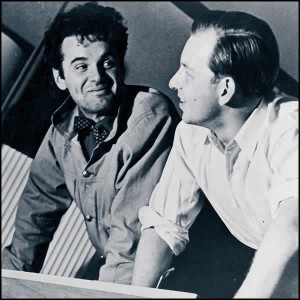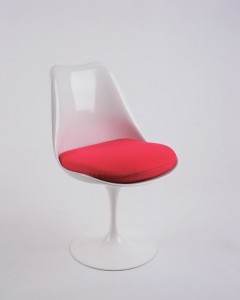
August 20th marks the 100th anniversary of the birth of Finnish architect/designer Eero Saarinen.
Eero Saarinen had - in all probability - very little career choice other than that of architect: Not only was his father Eliel Saarinen one of Finland's most celebrated architects, but two of his uncles followed the same profession. In addition his mother, Loja Gesellius Saarinen, was a sculptress and textile designer.
Eero Saarinen spent his first 13 years in his birthplace, Kirkkonummi on the outskirts of Helsinki. In 1923, following the positive feedback to Eliel Saarinen's entry for the Chicago Tribune Tower competition, the family emigrated to the USA - initially to Evanston, Illinois before in 1925 Eliel Saarinen was commissioned by G.G. Booth to build the new Cranbrook Academy of Art in Bloomfield Hills, Michigan.

A commission that was later to have a large influence on Eero's career.
In 1930 Eero travelled to Paris where he spent a year studying sculpture at L'Académie de la Grande Chaumière before enrolling at Yale School of Architecture from where he graduated in 1935. After a year travelling Europe and North Africa, Eero Saarinen returned to America where he began working in his fathers office at Cranbrook; and where he met Charles Eames for the first time. The young Eames both studying at the college and being employed in Eliel Saarinen's office.
The meeting was to be the start of a lifelong professional and personal relationship; Saarinen even naming the first son from his second marriage "Eames".

The professional careers of Charles Eames and Eero Saarinen were equally close and both effectively started with joint projects; the 1940 "Organic Design in Home Furnishings" competition and the 1945-49 "Case Study House #9" for Arts & Architecture Magazine.
In response to an increasing boredom in the USA with the minimalist steel/leather/glass objects of the Bauhaus School, the Museum of Modern Art in New York organised in 1940 a competition entitled: "Organic Design in Home Furnishings" to find the best new American furniture design concepts. The competition rules called for designs that were functional, affordable and based on new, modern production processes.
Eames and Saarinen submitted an entry comprising eight designs based largely on their early experiments with moulded synthetic furniture and that included, amongst others, the Conversation Chair or as it is more popularly known today, the Organic Chair.
The jury, including such luminaries as Marcel Breuer and Alvar Aalto, awarded Charles Eames and Eero Saarinen first prize.

While the award brought the pair recognition, the mass production of the Eames-Saarinen designs was still impractical in the early 1940s. The technology simply not being rife enough to either produce the chairs nor the machines required to produce the chairs. The approach used, however, was to be important in both designers later furniture design work. Charles Eames employing it for his fibreglass/plastic chair series; while Saarinen used it in his works for Knoll International, most notably the Womb Chair and the Tulip Chair - arguably his two most important designs.
Eames and Saarinen's architectural careers also involved an early joint project. In January 1945 the US Magazine Arts & Architecture publisher John Entenza wrote an editorial calling for greater use of mass production technology in house building. In the following years a series of leading architects were commissioned to design and build their vision of the industrial mass produced house of the future.
In 1949 "Case Study House #9" by Charles Eames and Eero Saarinen was completed. Showing the typical quadratic nature of most of Eames and Saarinen's early work,"Case Study House #9" is filled with fixtures, features and furniture that illustrate both mens belief in the unity between architecture and design and the importance of the relation between a building, its contents and its user.
Next door to "Case Study House #9" is "Case Study House #8" the so-called "Eames House": officially accredited to Charles and Ray Eames, but where one also detects the influence of Eero Saarinen.
For both Saarinen and Eames, their participation in such a prestigious project was to bring the two, still relatively young, architects a greater public and greater authority.
In 1946 another of Eero Saarinen's "Cranbrook Connections" lead to the start of his collaboration with Knoll International.

At Cranbrook Saarinen had met Florence Schust. In 1944 Florence married the young German furniture producer Hans G. Knoll and became the Knoll International "in-house interior designer"; and it was Florence Knoll who approached Saarinen to ask him to develop his moulded chair concept for the company.
In total Saarinen developed over a dozen products for Knoll International, many of which have been in continuous production since their launch.
Despite the importance of his work, for Eero Saarinen furniture design was a side project to his architecture career; a career which saw him build, amongst other buildings, the Jefferson National Expansion Memorial in St Louis, the TWA Terminal at JFK Airport New York and Dulles International Airport, Washington. That said it was never a lesser value work for Saarinen, who was fascinated by the concept that each part of a work could reflect and compliment the others, that outside and inside could be united as one entity. In that sense Saarinen's furniture designs can be seen as a direct extension of his architectural work. And his architectural work as an extension of his furniture design.
On September 1st 1961 Eero Saarinen died following an operation on a brain tumour.
Despite dying young, in his 25 year career Eero Saarinen created a canon of work - both architectural and furniture designs - that not only helped redefine architectural theory and shaped future thinking, but also laid the foundations for much of the modern designer furniture industry.